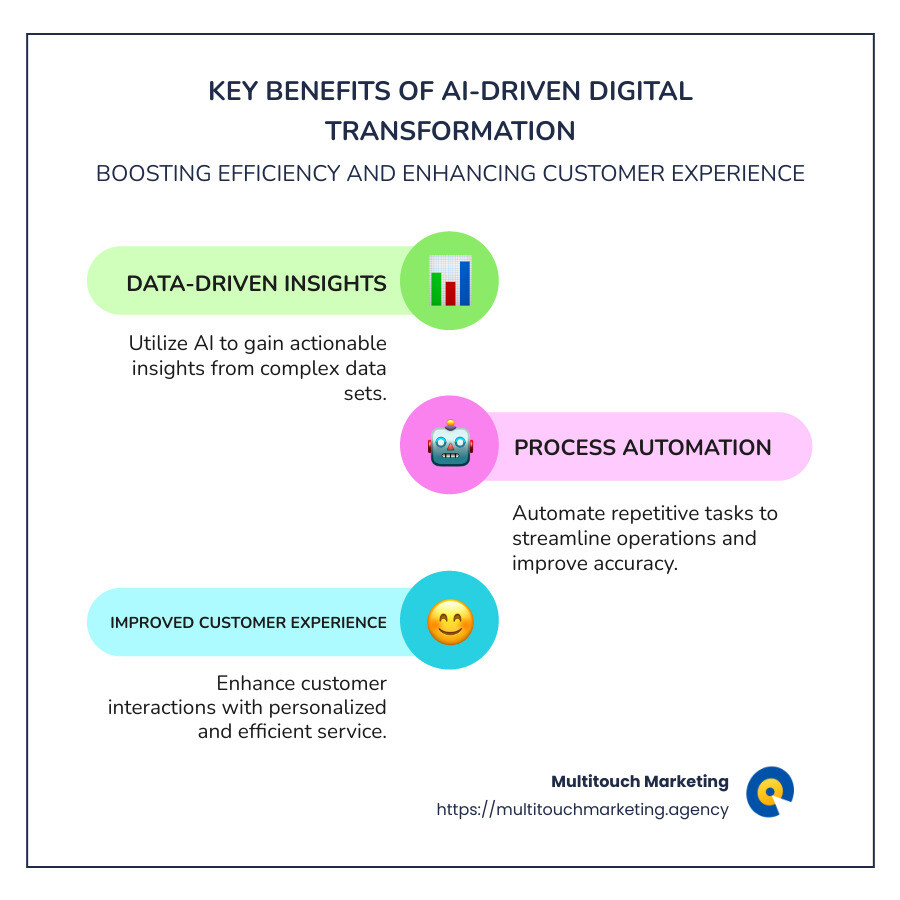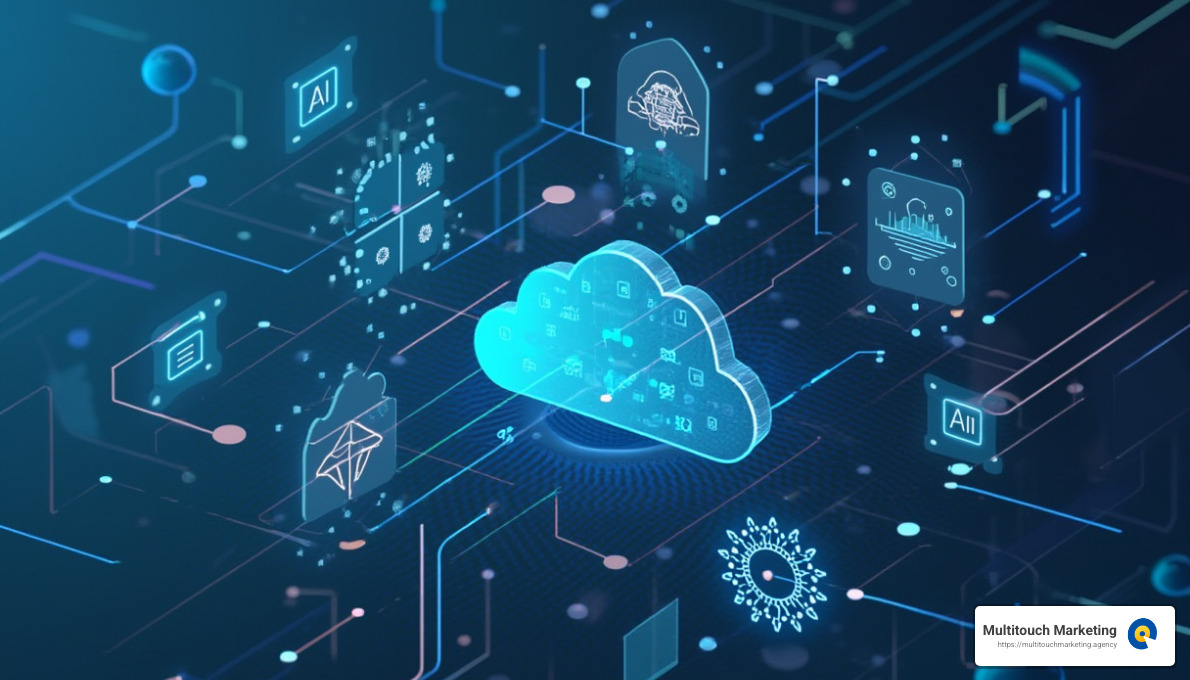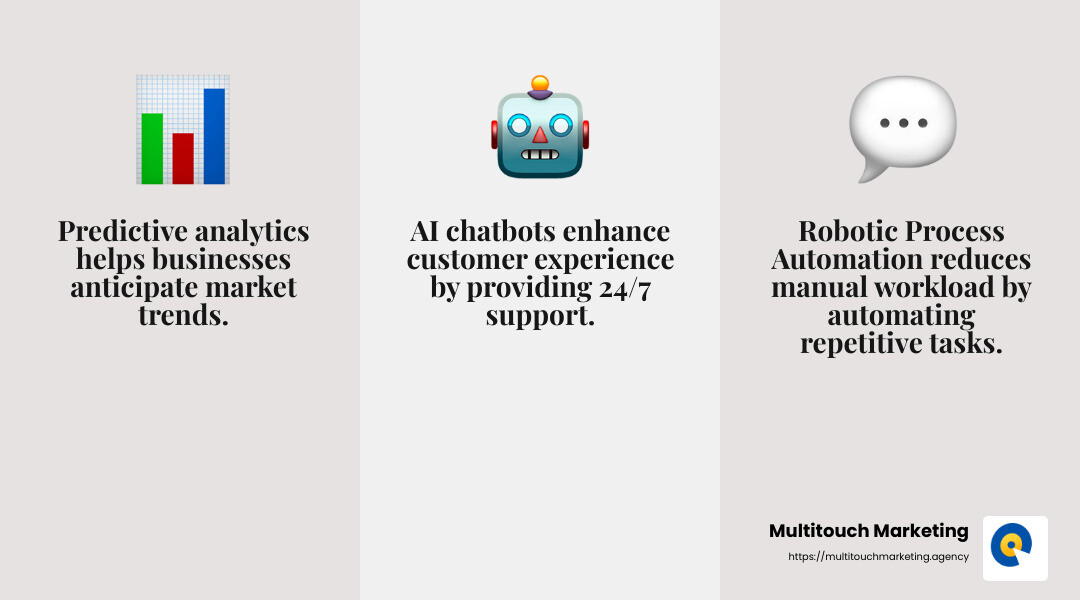AI-driven digital change is reshaping how businesses operate and grow. This strategic shift incorporates artificial intelligence to boost efficiency, streamline processes, and improve customer experiences. Whether you’re aiming to increase sales or optimize your online presence, embracing AI can provide a significant competitive advantage.
- What is AI-driven digital change?
- The integration of AI technologies to improve business operations and strategy.
- Why is it important?
- Offers data-driven insights
- Automates repetitive tasks
- Improves customer interactions
This change not only redefines operational workflows, but it also enables companies to stay ahead in an changing digital landscape. As my expertise from years of navigating AI-driven digital change suggests, businesses embracing this change see notable improvements in their strategic initiatives.
AI-driven digital change terms you need:
Understanding AI-Driven Digital Change
AI-driven digital change is not just a buzzword; it’s a fundamental shift in how businesses operate, adapt, and thrive. It involves integrating AI into every aspect of a business, from operations to customer interactions. This change is pivotal for staying competitive in today’s digital world.
AI Change
AI change is about changing traditional business processes. By using AI, companies can automate tasks, analyze data in real-time, and make informed decisions. For example, AI algorithms can process large datasets to uncover trends and patterns that might otherwise go unnoticed. This capability enables businesses to make proactive decisions, offering a significant edge over competitors.
Business Model Change
AI doesn’t just improve existing processes; it can revolutionize business models. Consider how AI-driven insights can lead to new revenue streams or service offerings. For instance, a retail company might use AI to personalize shopping experiences, increasing customer loyalty and sales. Businesses that adapt their models to incorporate AI often find themselves leading their industries.
Cloud Change
The cloud is a crucial enabler of AI-driven digital change. Cloud technology offers the scalability and flexibility needed to deploy AI solutions effectively. Many organizations are moving to the cloud to access AI tools and resources on-demand. This move not only supports innovation but also improves agility, allowing businesses to respond swiftly to market changes.
In summary, AI-driven digital change is about more than just technology; it’s about reshaping how businesses think and operate. By embracing AI and cloud technologies, companies can open up new possibilities and drive significant growth.
Key Benefits of AI-Driven Change
AI-driven digital change offers numerous advantages that can reshape the way businesses operate. Let’s explore three key benefits: data-driven insights, process automation, and improved customer experience.
Data-Driven Insights
AI excels at processing vast amounts of data quickly and accurately. By analyzing data, AI can reveal patterns and trends that might otherwise remain hidden. This capability allows businesses to make informed, strategic decisions.
For instance, predictive analytics powered by AI can help companies anticipate market trends and customer behavior. This foresight enables businesses to plan proactively, whether it’s forecasting product demand or identifying potential operational risks. According to a McKinsey report, companies that effectively leverage data-driven insights can significantly improve their decision-making processes.
Process Automation
One of the most practical benefits of AI is its ability to automate repetitive tasks. This automation reduces the workload on human resources and minimizes errors. Robotic Process Automation (RPA) is a perfect example. It streamlines activities such as data entry and invoicing, freeing up employees to focus on more strategic tasks.
Moreover, AI-driven automation is expanding into more complex areas, such as medical diagnostics and financial forecasting. This growth in automation capability enables businesses to operate more efficiently and effectively.
Improved Customer Experience
AI improves customer interactions through tools like chatbots and virtual assistants. These AI-powered solutions provide 24/7 support, answering questions and guiding users through various processes. They use natural language processing to deliver accurate, helpful responses, significantly improving the customer experience.
A case study from Movate highlights how AI-driven solutions can improve customer satisfaction while optimizing costs. By implementing self-service options, they were able to provide faster responses and reduce reliance on higher-cost support tiers.
In summary, AI-driven digital change empowers businesses to harness data-driven insights, streamline operations through automation, and improve customer experiences. By leveraging these benefits, companies can position themselves for sustained growth and success in the digital age.
Next, we’ll explore how businesses can implement AI in their operations, focusing on machine learning, natural language processing, and computer vision.
Implementing AI in Business Operations
Implementing AI-driven digital change in business operations can seem daunting, but it becomes manageable when broken down into key technologies: machine learning, natural language processing, and computer vision.
Machine Learning
Machine learning (ML) is at the heart of AI. It enables systems to learn from data and improve over time without being explicitly programmed. In business, ML can optimize processes like supply chain management and predictive maintenance.
For example, a healthcare company might use ML to accelerate drug findy. By analyzing molecular structures, ML models can identify promising compounds faster than traditional methods.
Natural Language Processing
Natural language processing (NLP) allows computers to understand and respond to human language. This technology powers chatbots and virtual assistants, enhancing customer support by providing instant, accurate responses.
A notable case is Ping Identity, which uses NLP to transform customer care. With generative AI, they leverage large language models to improve how they handle customer inquiries, enhancing both speed and accuracy.
Computer Vision
Computer vision enables machines to interpret and make decisions based on visual data. This technology is used in applications like quality control in manufacturing and automated checkout in retail.
For instance, computer vision can identify machinery needing maintenance by analyzing images or videos. This proactive approach reduces downtime and improves operational efficiency.
By incorporating these technologies into their operations, businesses can open up new levels of efficiency and innovation. AI-driven solutions not only streamline processes but also provide valuable insights that drive growth.
Next, we’ll dig into the top trends in AI and digital change, including cloud computing integration and AI and IoT convergence.
Top Trends in AI and Digital Change
As businesses accept AI-driven digital change, staying on top of emerging trends is crucial. Here are some of the most significant trends shaping the future of AI and digital change:
Cloud Computing Integration
Cloud computing is a game-changer for businesses looking to innovate and stay agile. By leveraging the cloud, companies gain access to on-demand AI tools, which are essential for scaling and flexibility. Many organizations are moving to the cloud to improve their digital change efforts, allowing them to deploy AI solutions quickly and efficiently.
A great example is how companies are using cloud platforms to process large datasets for AI applications. This approach not only reduces infrastructure costs but also accelerates innovation by allowing teams to experiment and iterate rapidly.
AI and IoT Convergence
The convergence of AI and the Internet of Things (IoT) is revolutionizing industries like manufacturing and healthcare. IoT devices generate massive amounts of data, which AI can analyze to provide actionable insights. This combination enables real-time monitoring and optimization of processes, significantly boosting productivity.
For instance, in manufacturing, AI can analyze data from IoT sensors to predict equipment failures before they occur. This proactive maintenance approach minimizes downtime and improves efficiency. In healthcare, IoT devices can track patient vitals, and AI can analyze this data to alert doctors to potential health issues.
Augmented Analytics
Augmented analytics is changing how businesses make decisions. By combining AI with analytics, companies can automate data preparation and analysis, leading to faster and more accurate insights. This trend empowers employees at all levels to make data-driven decisions without needing deep technical expertise.
A key benefit of augmented analytics is its ability to uncover hidden patterns and trends in data that might otherwise go unnoticed. This capability enables businesses to anticipate market changes, understand customer behavior, and identify new opportunities for growth.
By keeping an eye on these trends, businesses can harness the full potential of AI to drive digital change and stay ahead in a rapidly changing landscape.
In the next section, we’ll address frequently asked questions about AI-driven digital change, including its impact on business processes and common challenges.
Frequently Asked Questions about AI-Driven Digital Change
What is AI-driven digital change?
AI-driven digital change is all about using artificial intelligence to transform how businesses operate and deliver value. It’s not just about adopting new technology; it’s a strategic initiative that reshapes business models and processes. Companies leverage AI to innovate and stay competitive, making AI an essential part of their digital change journey. By integrating AI into their operations, businesses can automate tasks, gain deeper insights from data, and improve customer experiences.
How does AI affect digital change?
AI significantly impacts digital change by changing business processes and boosting efficiency. It enables businesses to automate repetitive tasks, freeing up time for employees to focus on more strategic activities. This leads to increased productivity and growth. AI also improves decision-making through data-driven insights, helping companies understand market trends and customer needs better. By incorporating AI, businesses can innovate faster and adapt to changing environments, maintaining a competitive edge.
What are the challenges of AI-driven change?
While AI-driven digital change offers numerous benefits, it also presents challenges. One major challenge is ensuring data quality. AI systems rely on accurate and clean data to function effectively, so poor data can lead to incorrect insights and decisions. Ethical AI is another concern, as businesses must ensure that their AI systems are fair and unbiased. Additionally, skill gaps can hinder AI adoption. Companies need to invest in training and upskilling their workforce to fully leverage AI technologies. Addressing these challenges is crucial for successful AI-driven change.
The Wrap Up
As we wrap up our exploration of AI-driven digital change, it’s clear that the integration of AI into business strategies is not just a trend but a necessity. At Multitouch Marketing, we recognize the transformative power of AI, especially in the field of digital marketing and PPC advertising.
Digital marketing has evolved dramatically with AI. It’s no longer just about reaching audiences; it’s about understanding them deeply and delivering highly personalized experiences. AI helps us analyze vast amounts of data to gain insights into consumer behavior, enabling us to craft targeted campaigns that resonate with specific audiences.
In PPC advertising, AI plays a pivotal role. It allows us to optimize ad spend by predicting which ads will perform best, thus maximizing return on investment. This is crucial in a field as dynamic and complex as PPC, where staying ahead of the competition is vital. Our expertise in navigating these complexities ensures that businesses not only reach their target audiences but also engage them effectively.
At Multitouch Marketing, we’re committed to helping businesses harness the full potential of AI. Whether it’s through crafting strategic PPC campaigns or offering insights into digital trends, our goal is to ensure our clients thrive in an AI-driven world.
Ready to transform your business with AI? Contact us today to explore how we can lift your digital marketing strategy and drive success through AI-powered solutions.




